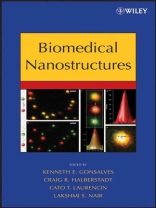Learn to Use Nanoscale Materials to Design Novel Biomedical Devices
and Applications
Discover how to take full advantage of nanoscale materials in the
design and fabrication of leading-edge biomedical devices. The
authors introduce you to a variety of possible clinical
applications such as drug delivery, diagnostics, and cancer
therapy. In addition, the authors explore the interface between
micron and nanoscale materials for the development of applications
such as tissue engineering. Finally, they examine the mechanisms of
cell interactions with material surfaces through the use of
nanotechnology-based material processing and characterization
methods.
The text’s three sections highlight its interdisciplinary
approach:
* Part One: Nanostructure Fabrication
* Part Two: Bio-Nano Interfaces
* Part Three: Clinical Applications of Nanostructures
Among the key topics covered are nanotechnology in tissue
regeneration; biomolecular engineering; receptor-ligand
interactions; cell-biomaterial interactions; nanomaterials in
diagnostics, drug delivery, and cancer therapy; and nano- and
micron-level engineering and fabrication.
Throughout the text, clear examples guide you through the chemistry
and the processing involved in designing and developing nanoscale
materials for biomedical devices. Each chapter begins with an
introduction and ends with a conclusion highlighting the key
points. In addition, references at the end of the chapter help you
expand your research on any individual topic. In summary, this book
helps biomedical researchers and engineers understand the physical
phenomena that occur at the nanoscale in order to design novel
cell-based constructs for a wide range of applications.
Содержание
PART I. NANOSTRUCTURE FABRICATION.
1. Nanofabrication Techniques.
2. Micro/ Nano-Machining and Fabrication of Materials for
Biomedical Applications.
3. Novel Nanostructures as Molecular Nanomotors.
4. Bioconjugation of Soft Nanomaterials.
5. Nanotechnology and Drug Delivery.
6. Polymeric Nano Particles and Nanopore Membranes for Controlled
Drug and Gene Delivery .
7. Development of Nanostructures for Drug Delivery
Applications.
8. Bioconjugated Nanoparticles for Ultrasensitive Detection of
Molecular Biomarkers and Infectious Agents.
PART II. BIO-NANO INTERFACES.
9. ECM Interactions With Cells From The Meso To Nano Scale.
10. Cell Behavior Towards Nanostructured Surfaces.
11. Cellular Behavior on Basement Membranes Inspired
Topographically Patterned Synthetic Matrices.
12. Focal Adhesions: Self-Assembling Nanoscale Mechanochemical
Machines that Control Cell Function.
13. Controlling Cell Behavior via DNA and RNA Transfections.
14. Multi-Scale Co-Culture Models for Orthopaedic Interface
Tissue Engineering.
PART III. CLINICAL APPLICATIONS OF NANOSTRUCTURES.
15. Nanostructures for Tissue Engineering/Regenerative
Medicine.
16. Nanostructures for Cancer Therapy.
17. Clinical Applications of Micro-and Nano Scale Biosensors.
18. Nanoscale Iron Compounds Related to Neurodegenerative
Disorders.
19. Application of Nanotechnology into Life Science: Benefit or
Risk.
Об авторе
Kenneth E. Gonsalves, Ph D, is Distinguished Professor in the Department of Chemistry at the University of North Carolina at Charlotte. Dr. Gonsalves has more than fifteen years of experience in using photolithography and chemistry to develop materials that have features at both the micron and nanoscale. Working with Dr. Craig Halberstadt, he has successfully demonstrated the ability to create a new material that can be controlled at both these size scales to influence cell behavior. He has also developed active polymeric nanoparticles for delivery of antibiotics and genes. Craig R. Halberstadt, Ph D, is Director of Tissue Engineering and Senior Research Scientist at the Cannon Research Center of Carolinas Medical Center. Dr. Halberstadt is a pioneer in the development of a scalable commercial process for the growth of a human skin product. He has also published extensively on cell/biomaterial interactions for cellular transplantation. Cato T. Laurencin, MD, Ph D, is Lillian T. Pratt Distinguished Professor and Chair of the Department of Orthopaedic Surgery and Professor of Biomedical Engineering and Chemical Engineering at the University of Virginia. He has also been designated one of fifteen University Professors at the School. He has authored more than 250 peer-reviewed articles and has edited books in the areas of biomaterials, orthopaedic tissue engineering, and nanotechnology. He is the recipient of several national and international awards and was elected to the National Academy of Sciences, Institutes of Medicine. His current research interests include biomaterial synthesis, orthopaedic tissue engineering, gene therapy, drug delivery, and nanotechnology. Lakshmi S. Nair, MPhil, Ph D, is Assistant Professor in the Department of Orthopaedic Surgery at the University of Virginia. She has authored more than fifty peer-reviewed articles in the areas of biomaterials, tissue engineering, drug delivery, and nanotechnology. Her research interests include hydrogels for tissue engineering and drug delivery, stimuli sensitive materials, and biomedical nanotechnology.












